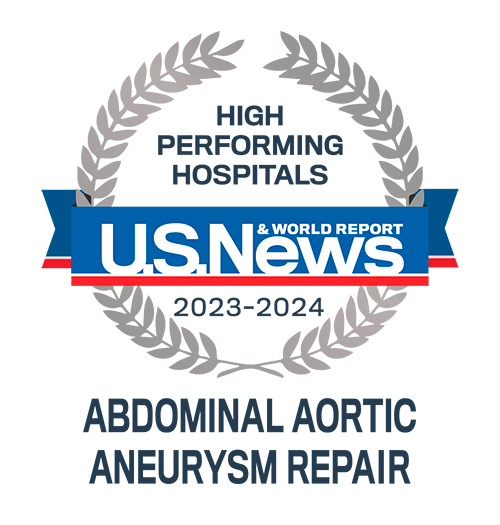Endovascular Aneurysm Repair (EVAR)
What Is EVAR?
An aortic aneurysm is a weak, bulging area in the aorta, the body’s largest artery. Endovascular aneurysm repair (EVAR) is a minimally invasive procedure used to manage abdominal aortic aneurysms (AAAs). AAAs are aneurysms that form in the lower part of the aorta. The purpose of EVAR is to prevent the AAA from bursting (rupture) or tearing (dissection), both of which are life-threatening events. EVAR techniques are also used in the treatment of thoracoabdominal aneurysms (TAAAs), which extend through the chest and abdominal sections of the aorta.
Make an Appointment
Call 440-613-2462 today.
Schedule OnlineDuring EVAR, a surgeon threads a graft (also called a stent graft) into the aneurysm, through a small incision in the groin. The graft is guided and positioned using advanced X-ray imaging technology. Once placed, the stent graft is expanded inside the aorta to create a stable path for blood to flow. The stent graft reinforces the weakened part of the aorta to prevent the aneurysm from rupturing.
Who Might Need EVAR?
If you have been diagnosed with an AAA or TAAA, you may be a candidate for EVAR. Not all aneurysms require treatment. Your doctor may consider EVAR for you if you:
- Have a large abdominal aneurysm or a smaller abdominal aneurysm that is growing at a fast rate.
- Do not qualify for open surgery, which requires a large incision to be made in the abdomen.
- Have healthy blood vessels close to the aneurysm.
Benefits of EVAR
Benefits of EVAR in comparison to open surgery include:
- Shorter procedure time and hospital stay.
- Less blood loss.
- Reduced post-op discomfort.
- Faster return to normal daily activities.
- Reduced risk of a experiencing a heart attack or other life-threatening complications during the procedure.
Risks of EVAR
Although EVAR has a high success rate and is generally considered safe, there is chance of complications, including:
- Blood clots
- Deep vein thrombosis (DVT)
- Endoleak (leaking of blood outside the stent graft and inside the aneurysm sac)
- Infection
- Kidney failure
- Heart attack
- External bleeding
Why Choose University Hospitals for EVAR?
Unparalleled clinical expertise
Highest quality patient outcomes
Office visits and imaging coordinated on the same day
Quick, convenient access with sites across the region
Virtual appointment option for follow up care

University Hospitals Harrington Heart & Vascular Institute is a pioneer in endovascular medicine, providing novel endovascular treatment to communities in Northeast Ohio and beyond. We earned a “High Performance” rating – the highest rating possible – for abdominal aortic aneurysm repair in the U.S. News & World Report 2023 – 2024 “Best Hospitals” survey, which evaluated data from more than 4,500 hospitals across the country.
What Happens During the EVAR Procedure?
An EVAR procedure typically lasts between three and six hours depending on the complexity of the aneurysm. The steps of the procedure are as follows:
- You receive anesthesia so that you sleep during the procedure.
- The surgeon makes a small incision in your groin.
- The surgeon inserts needles through the incision to access your femoral arteries.
- The surgeon inserts catheters (thin tubes) into the needles. One of the catheters contains the expandable stent graft. Using real-time imaging, your provider guides the graft through your arteries to the aortic aneurysm.
- After the graft reaches the aneurysm, the surgeon expands it to form a new path through which blood can flow. The graft’s wire frame creates a tight seal that holds it in place and stops blood from leaking into the aneurysm.
- When the procedure is complete, the surgical team removes the catheter.
- The puncture site in the groin is so small that stitches are not needed. A bandage is applied to the wound to help it heal faster.
What Happens After EVAR?
Unless complications occur, most EVAR patients stay at the hospital ward for one to three days. You can eat and drink normally once you fully awaken from the anesthesia. Nurses will assist in you in sitting up and help you get back to walking as soon as possible.
Once you return home, you may get tired easily and require pain medication for a few days. You should not drive while you are taking pain medication. Most people return to work within a month of the procedure. You should avoid lifting anything heavy for four to six weeks after EVAR.
Full recovery from endovascular aortic aneurysm treatment typically takes between three and six months. Your age and general level of fitness can affect the length of your recovery.
Although rare, some people experience issues such as endoleaks, or leaking of blood outside the stent graft and within an aneurysm sac. Such issues can occur even years after having an EVAR procedure. Even with successful EVAR treatment, you may develop another aneurysm. Your doctor may recommend ongoing monitoring and imaging studies.


